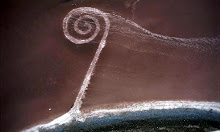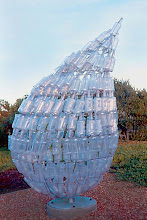Friday, February 26, 2010
Susan Howe and situatedness
Below is the first stanza of "Rückenfigur." Notice how each line breaks not where the idea ends, but right about where the reader needs to take a breath. For the full poem, click here.
Iseult stands at Tintagel
on the mid stairs between
light and dark symbolism
Does she stand for phonic
human overtone for outlaw
love the dread pull lothly
for weariness actual brute
predestined fact for phobic
falling no one talking too
Tintagel ruin of philosophy
here is known change here
is come crude change wave
wave determinist comparison
Your soul your separation
Wednesday, February 24, 2010
Site-Specificity in Music
A question to consider:
Can site specific music be reproduced?
Tuesday, February 23, 2010
Site-Specificity in Dance
As a basic working definition, site-specific dance involves the artist performing in the real world, using the location and its surroundings as part of the piece. Interestingly, some believe that site-specific dance stemmed from unhappy dancers who participated in dance companies. As a result of this discontent, the dancers left the theater and began to perform in the streets and other locations outside of the theater, combining choreography and improvisation to form a performance piece based on the site picked.
Major areas, such as Hong Kong, now encourage site-specific dance as a means of expressing creativity and hold festivals in order to show their support for the creation of this unique art form. In 2007, Hong Kong introduced the first Site-Specific Dance Festival, inviting people from all around the world to perform in the streets. Since then, other major cities have opened their facilities and invited dancers to create a performance within a certain space. The dancers are challenged to work within the space provided as well as around any other people that are present. Some of the artists provide their own props, allowing passers-by to interact with them, adding to the specificity of the site as well as adding a situational aspect to their performance. However, there are also other artists who act as though they are the only ones in the room, ignoring other people by moving around them. An interesting example of this sort of variety of site-specific dance can be found in Beyond the Threshold: Seattle International Dance Festival.
Questions to consider:
-Can anyone create a site-specific dance? If this is the case, what is the difference, if any, between street performers and site-specific dancers?
-Does having someone else dictate the site in which you perform (such as in these site-specific dance festivals) change the significance of the piece?
Monday, February 22, 2010
Olson, America, & Projective Verse

Charles Olson, one of America's most profound modern poets, created the idea of "projective verse" which, according to him centers around the idea of the poem's lines being reflective of the actual meaning of the poem using breaks to synchronize with the breath of the reader. This is particularly relative to situation in that the work then works with the situation; that is to say it is in sync with the situational being of the poem itself.
Site-Specificity in Literature

References:
Butterick, George F. Editing The Maximus Poems: Supplementary Notes. Storrs: University of Connecticut Library, 1983. Print.
Olson, Charles. The Maximus Poems. Ed. George F. Butterick. Berkeley: University of California, 1983. Print.
Wednesday, February 17, 2010
Maximus, Ezra Pound & Envelopes

It bears mentioning that situation is a loose term. It's easy to call whatever you want a situation. I suppose when I write about it, it means a great deal more than just the elementary diagram I drew on the board (external forces->neutral stimulus->result), but it is also fairly subjective. To artists, it remains a medium through which they can make points. Avant garde art in particular utilizes the situation to express their beliefs and opinions. I see it as the point in which you cannot discern any more from the physical entity and its naked information.
Monday, February 15, 2010
Situationism & Ephemerality

The idea of situationist art, the setting up of "predicaments" in society is most likely the point in which the idea of situation and site-specific art cross.
Victoria Newhouse on Art Placement
She describes how the location of a piece can completely change its meaning. In looking at Michelangelo's famous sculpture, David, she tells how it was originally commissioned to be built for a part of a cathedral. However, when the statue was almost complete, Michelangelo wanted to look for different sites for his piece, eventually finding a home in front of the city's town hall. Newhouse comments: "Had the David adorned the cathedral, he would have been a biblical hero; in front of the town hall, he became a symbol of the city government. Placed high up on a rostrum and parapet...next to the entrance portal and boldly facing south toward Rome, the David was seen by many in Florence as a warning to their Goliath: the exiled Medici who opposed the Florentine Republic." Her example of the David statue clearly shows how a piece of artwork can be interpreted differently based on its location.
Another example she gives her readers is that of the Elgin Marbles (Parthenon Marbles), a series of marble carvings once part of the Parthenon. The sculptures depict the birth of Athena and her competition with Poseidon. They were placed specifically at a high point, lining the cornice, intended to be seen from that viewpoint. The idea behind this was to show that the deities resided far above the mortal world, however, the statues were moved. The Elgin Marbles now reside in the British Museum at eye level, stripping the piece of its original significance as well as completely changing its surroundings. Furthermore, the figures no longer face outward, but instead "they now face each other across the gallery's interior, thereby destroying the narrative of the frieze and the overall processional relationship of the different groups to one another." Though the Marbles were moved due to reasons of preservation, we can see how their displacement causes them to lose their significance.
From these two examples, we can see how the site can truly affect a piece and how it has the ability to alter the meaning of the work entirely.
Reference:
Newhouse, Victoria. Art and the Power of Placement. New York: The Monacelli Press, 2005. Print.
Thursday, February 11, 2010
Rachel Whitread's "House" (1993)
A perfect example of site-specific work, artist Rachel Whiteread made this concrete installation in order to call attention to a piece of English architectural history which was being torn down to make way for a new public park. She sprayed concrete on the inside of all the walls of a Victorian era house in a London block. The walls were then removed, leaving just the shell of the house. This piece remained installed in the new park for a year before it was destroyed. It was a physical reminder of the cost of progress, even if the end result was favorable (a city park). Something has to be moved or destroyed to make room, and in this case it was a block of historic homes.
Wednesday, February 10, 2010
Meredith Monk is Coming to Wake Forest!!

Along with several other artists, Monk will be part of the WFU Entrepreneurship department's Creativity Symposium March 18-20
Remaining Thoughts on Today's Presentation
As we discovered through our discussion in class today, site-specific art is a difficult concept to approach. In its most basic sense, site-specific art is artwork created to exist in a certain place. The combination of the work of art and the places in which it is located define its meaning. From this, we can gather that the site-specific work creates a sort of "relationship" with its location.
This idea of site-specificity raises several questions. To respond to Serra's quote above, do you think moving a piece of art destroys it? Or does it only change the significance of the piece? Perhaps for an artist, changing the significance of the work is to destroy it.
We brought up the image of Wait Chapel and the significance of its location on campus. Placed in a prime location on the Reynolda Campus, it is situated at the “heart of a cross” (aligning it on the grid which defines the campus architecture) where everyone can easily view it. Chiefly significant because it connects the viewer with the religious identity (Baptist affiliation) that Wake Forest University once had, if placed in an entirely different setting, would Wait Chapel lose its significance? In this case, is the work site-specific or is it culturally and/or socially-specific?
Questions About Today's Reading
In our book, Site-Specific Art: Performance, Place and Documentation, we pulled several examples of performance "art."
1. One particular artist, Acconci, decided to sit in a small theater and stare at each member of the audience for 30 seconds at a time. He deemed their reactions art (155).
In this case, does the impermanence or changing nature of the piece of art make it less special? Obviously each audience member's reaction changes based on his/her own experience with Acconci's gaze, so the "art" constantly changes.
This also resonates with the presentation on Beauty where the group proposed these questions: Is art (or beauty) private or socially inscribed? Do we find the meaning in our own personal experience or in what others tell us?
2. Another example pulled from the book is of Meredith Monk, who performed a dance in three different places and deemed them site-specific (119-123).
This rasied the question of whether or not works of art can be transferred to different places. Can you re-create a site? Does the re-created site lose its significance?
Environmental Art
A branch of site-specific art which emerged in the 1960s, environmental art is concerned with our relationship to the natural world, attempting to find our place (either in harmony or discord) with the environment. Like most site-specific art it is usually ephemeral (either disappearing or transforming a short time after its creation). It is often designed for one particular location and most modern pieces offer a social or political commentary as well. In addition, environmental art involves a collaboration between artists or people in other disciplines (e.g. scientists, educators, and other members of the community.)
A question to consider:
Does the impermanence of this environmental art make it more or less special?
Site-Specific Architecture
One of Frank Gehry's most famous buildings it is made up of curved, interconnected shapes cased in bright titanium, giving the shimmering appearance of fish scales. At its core is a large, light-filled atrium, which has views of Bilbao's estuary and the surrounding hills. Opened in 1997, it was deemed "the greatest building of our time" by architect Philip Johnson, and although it was designed to house substantial site-specific pieces, Gehry's architecture is often thought to eclipse the artworks it contains. Costing $100m, it paid for itself within just one year, and has been credited with kicking off a cultural and economic revival in the Basque country.
To check out more architecture by Frank Gehry look no further than the ZSR!
Identifying Site-Specific Art
This link shows part of the collection from the Museum of Modern Art (MOMA) in New York.
Now that you are all familiar with the concept of this type of art, try browsing the online gallery and see if you can identify pieces which exemplify the site-specific.
Monday, February 8, 2010
Curious about our Title Picture?
The captivating image at the top of our blog is one of the most recognized pieces of site-specific art, Richard Serra's Tilted Arc. Commissioned by the US government in 1981 to be placed in the open space in front of the Federal Plaza in New York City, it consists of a solid unfinished plate of steel (120ft long and 12ft high) placed in the center of the space.
For Serra, "The viewer becomes aware of himself & of his movement through the plaza. As he moves, the sculpture changes. Contraction & expansion of the sculpture result from the viewer's movement. Step by step the perception not only of the sculpture but of the entire environment changes."
The sculptures generated controversy as soon as it was erected, with critics saying it interfered with public use of the plaza and attracted graffiti, rats, and terrorists. Four years later, a public hearing was held to determine if it should be relocated. Serra testified that the sculpture was site-specific, and that to remove it from its site was to destroy it. Additionally he said if the sculpture was relocated, he would remove his name from it. Regardless it was dismantled in 1989.
The Tilted Arc, generated many questions about public art. The role of government funding, an artist's rights to his/her work, the role of the public in determining the value of a work of art, and whether public art should be judged democratically are all heatedly debated.
Sunday, February 7, 2010
Reading Assignment for 2/10
Spaces (p. 25)
Performing the Gallery: Robert Morris and Michelangelo Pistoletto p. 30-33
Architecture and Event: Bernard Tschumi p. 41-45
Michelangelo Pistoletto: Le Stanze (just scan...mainly pictures) p. 59-89
Site (p. 91)
Mapping Site: Robert Smithson p. 92-95
Space as Map and Memory p. 119-123
Materials (p. 139)
Embodying Site: Dennis Oppenheim and Vito Acconci p. 151-156, 161-163
Station House Opera: The Breeze Block Performances (just scan...mainly pictures) 170-181
Frames (p. 183)
Repetition and Location: Daniel Buren p. 184-185, 190-192
Framed and Being Framed: Hans Haacke p. 196-198









